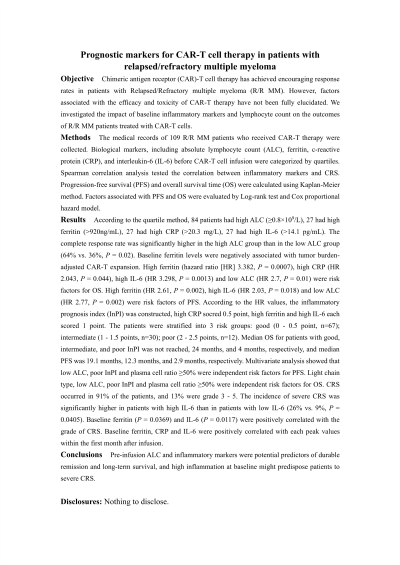Cellular and T cell engager Immunotherapy
Poster Session 1
P-029: Prognostic markers for CAR-T cell therapy in patients with relapsed/refractory multiple myeloma
Wednesday, September 27, 2023
1:30 PM - 2:30 PM EEST


yang liu, 30220190632033100006
99 West Huaihai Road, Xuzhou 221002, China
Department of Hematology, The Affiliated Hospital of Xuzhou Medical University, United States
Introduction: Chimeric antigen receptor (CAR)-T cell therapy has achieved encouraging response rates in patients with Relapsed/Refractory multiple myeloma (R/R MM). However, factors associated with the efficacy and toxicity of CAR-T therapy have not been fully elucidated. We investigated the impact of baseline inflammatory markers and lymphocyte count on the outcomes of R/R MM patients treated with CAR-T cells.
Methods: The medical records of 109 R/R MM patients who received CAR-T therapy were collected. Biological markers, including absolute lymphocyte count (ALC), ferritin, c-reactive protein (CRP), and interleukin-6 (IL-6) before CAR-T cell infusion were categorized by quartiles. Spearman correlation analysis tested the correlation between inflammatory markers and CRS. Progression-free survival (PFS) and overall survival time (OS) were calculated using Kaplan-Meier method. Factors associated with PFS and OS were evaluated by Log-rank test and Cox proportional hazard model.
Results: According to the quartile method, 84 patients had high ALC (≥0.8×10^9/L), 27 had high ferritin (>920ng/mL), 27 had high CRP (>20.3 mg/L), 27 had high IL-6 (>14.1 pg/mL). The complete response rate was significantly higher in the high ALC group than in the low ALC group (64% vs. 36%, P = 0.02). Baseline ferritin levels were negatively associated with tumor burden-adjusted CAR-T expansion. High ferritin (hazard ratio [HR] 3.382, P = 0.0007), high CRP (HR 2.043, P = 0.044), high IL-6 (HR 3.298, P = 0.0013) and low ALC (HR 2.7, P = 0.01) were risk factors for OS. High ferritin (HR 2.61, P = 0.002), high IL-6 (HR 2.03, P = 0.018) and low ALC (HR 2.77, P = 0.002) were risk factors of PFS. According to the HR values, the inflammatory prognosis index (InPI) was constructed, high CRP socred 0.5 point, high ferritin and high IL-6 each scored 1 point. The patients were stratified into 3 risk groups: good (0 - 0.5 point, n=67); intermediate (1 - 1.5 points, n=30); poor (2 - 2.5 points, n=12). Median OS for patients with good, intermediate, and poor InPI was not reached, 24 months, and 4 months, respectively, and median PFS was 19.1 months, 12.3 months, and 2.9 months, respectively. Multivariate analysis showed that low ALC, poor InPI and plasma cell ratio ≥50% were independent risk factors for PFS. Light chain type, low ALC, poor InPI and plasma cell ratio ≥50% were independent risk factors for OS. CRS occurred in 91% of the patients, and 13% were grade 3 - 5. The incidence of severe CRS was significantly higher in patients with high IL-6 than in patients with low IL-6 (26% vs. 9%, P = 0.0405). Baseline ferritin (P = 0.0369) and IL-6 (P = 0.0117) were positively correlated with the grade of CRS. Baseline ferritin, CRP and IL-6 were positively correlated with each peak values within the first month after infusion.
Conclusions: Pre-infusion ALC and inflammatory markers were potential predictors of durable remission and long-term survival, and high inflammation at baseline might predispose patients to severe CRS.
Methods: The medical records of 109 R/R MM patients who received CAR-T therapy were collected. Biological markers, including absolute lymphocyte count (ALC), ferritin, c-reactive protein (CRP), and interleukin-6 (IL-6) before CAR-T cell infusion were categorized by quartiles. Spearman correlation analysis tested the correlation between inflammatory markers and CRS. Progression-free survival (PFS) and overall survival time (OS) were calculated using Kaplan-Meier method. Factors associated with PFS and OS were evaluated by Log-rank test and Cox proportional hazard model.
Results: According to the quartile method, 84 patients had high ALC (≥0.8×10^9/L), 27 had high ferritin (>920ng/mL), 27 had high CRP (>20.3 mg/L), 27 had high IL-6 (>14.1 pg/mL). The complete response rate was significantly higher in the high ALC group than in the low ALC group (64% vs. 36%, P = 0.02). Baseline ferritin levels were negatively associated with tumor burden-adjusted CAR-T expansion. High ferritin (hazard ratio [HR] 3.382, P = 0.0007), high CRP (HR 2.043, P = 0.044), high IL-6 (HR 3.298, P = 0.0013) and low ALC (HR 2.7, P = 0.01) were risk factors for OS. High ferritin (HR 2.61, P = 0.002), high IL-6 (HR 2.03, P = 0.018) and low ALC (HR 2.77, P = 0.002) were risk factors of PFS. According to the HR values, the inflammatory prognosis index (InPI) was constructed, high CRP socred 0.5 point, high ferritin and high IL-6 each scored 1 point. The patients were stratified into 3 risk groups: good (0 - 0.5 point, n=67); intermediate (1 - 1.5 points, n=30); poor (2 - 2.5 points, n=12). Median OS for patients with good, intermediate, and poor InPI was not reached, 24 months, and 4 months, respectively, and median PFS was 19.1 months, 12.3 months, and 2.9 months, respectively. Multivariate analysis showed that low ALC, poor InPI and plasma cell ratio ≥50% were independent risk factors for PFS. Light chain type, low ALC, poor InPI and plasma cell ratio ≥50% were independent risk factors for OS. CRS occurred in 91% of the patients, and 13% were grade 3 - 5. The incidence of severe CRS was significantly higher in patients with high IL-6 than in patients with low IL-6 (26% vs. 9%, P = 0.0405). Baseline ferritin (P = 0.0369) and IL-6 (P = 0.0117) were positively correlated with the grade of CRS. Baseline ferritin, CRP and IL-6 were positively correlated with each peak values within the first month after infusion.
Conclusions: Pre-infusion ALC and inflammatory markers were potential predictors of durable remission and long-term survival, and high inflammation at baseline might predispose patients to severe CRS.
